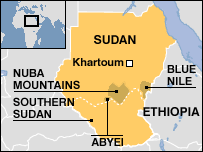Moro

Moro is a Kordofanian language spoken in the Nuba Mountain region of Sudan. Little linguistic work on the Kordofanian family has been undertaken. It remains one of the most poorly described language groups in Africa. This situation is partly due to the remoteness of the mountainous location, but also to civil war in Sudan.
The exact number of Moro speakers both within the traditional Moro-speaking area and elsewhere is not clear. Moro was reported to have 30,000 speakers in 1982, prior to the second Sudanese civil war. Although the 2005 Comprehensive Peace Agreement recognized minority languages and offered new hope for stability, peace in Sudan is fragile. As of July 2011, as South Sudan became an independent nation, the Nuba people are once again embroiled in war.
The Moro Language Project seeks to document this endangered language, and was supported with a grant (BCS-0745973) from the National Science Foundation from 2008-2013.* We are investigating the Thetogovela dialect (or Toberelda) with native speaker consultants Mr. Elyasir Afsos Julima and Ms. Ikhlas Elahmer. We have also worked with Mr. Angelo Naser, who runs the Moro Language Committee in Omdurman, Sudan. Our project has two main goals: documentation, including development of a grammar and lexicon, and analysis, both theoretical and typological.
There are over twenty Kordofanian languages, which together form one of the main branches of the Niger-Congo phylum. Existing literature on Kordofanian is sparse. The only previous grammar of Moro (Black & Black 1971) is a useful overview of the language, but does not recognize tone and describes a different dialect than Thetogovela. Population movement and the current development of a standard form by the Moro Language Committee in Khartoum may contribute to dialect shifting, making our research all the more urgent.
A descriptive grammar and lexicon will make a lasting contribution to African linguistics, and the complexities of Moro grammar will be of considerable interest to typologists, Africanists, and theoretical linguists. Noteworthy features of theoretical interest include tonal marking of morphological paradigms, variable morphotactics of object markers, wh-agreement, the marking of material in non-subject relative clauses, and fronted wh questions preceding the site of extraction.
* This material is based upon work supported by the National Science Foundation under Grant No. 0745973. Any opinions, findings and conclusions or recommendations expressed in this material are those of the author(s) and do not necessarily reflect the views of the National Science Foundation (NSF).